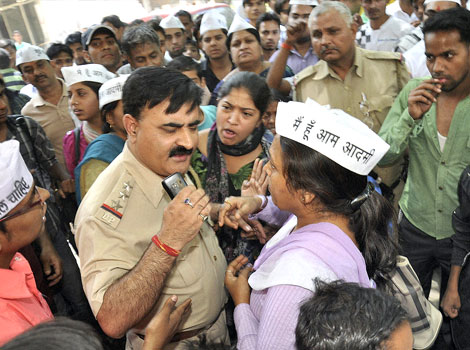Protests are bound to be political, but that politics can be broad as well as petty
Look at photographs or TV footage of the protests in the capital after the rape of a child last week and you can’t miss the branding: people there were drawing your attention as much to their anger as to the organisation they were affiliated with: the Aam Aadmi Party (AAP), BJP, CPI-ML (Liberation) or AIDWA.
Many would see nothing wrong in it, while some would think this is not fair. Nehru, too, had a view, and so did Gandhi, but more about that later.
[Check our Day’s Debate: Should political outfits let go of party flags while taking part in ongoing protest against rape?]
First let us consider the pragmatic view. After the earthquake of 2002, many religious, social and political organisations sent their teams to Kachchh for relief and rehabilitation work. Most volunteers wore a cap or t-shirt advertising their affiliation. Should one avoid taking credit for helping others? While that may be the right thing for an individual, an organisation needs to flaunt its work.
Thus, when many volunteers worked in tents administering first-aid or running kitchen, there would be one or two who would not bother with manual labour and only take photographs — for documentations. These photos were then uploaded on websites, which would prompt more people to come and join the effort, or at least send donations.
It would take an organisation, like the BJP or AAP in this case, to bring together hundreds or thousands of people for protests, and if it also uses the opportunity to do what marketing folks would call branding, it is not exactly unethical. A party sympathiser watching the events unfold on TV at home might well be inspired to go and join the protest. If somebody, say, Kavita Krishnan or Brinda Karat, is angry and is out to protest, a cap on her head or a flag in her hand need not make her anger or protest dubious.
If, in the process, they are “doing politics”, then, of course, we need more of politics — politics in the larger sense. As for petty politics, when Delhi assembly elections are round the corner, it can’t be avoided, from either side.
Now for the Gandhi-Nehru anecdote. After years of silence, when Gandhi announced he would protest against the salt tax, both the Congress and the British were surprised. Both thought Gandhi had got it wrong and this issue would not make any impact. They were wrong; people across the nation connected with Gandhi and great excitement started building up. On the eve of the march, Nehru came rushing to the Sabarmati Ashram.
Narayan Desai, in his four-volume biography of Gandhi (My Life is My Message), writes about the moments before the band of 79 marched out of the ashram onward to Dandi: “The team did not have a single flag, banner, placard or any kind of symbol. Nehru had made a suggestion of putting (Congress) badges (on shoulder bags) but Gandhi laughed it off as naïve. But before Gandhi joined the team, Nehru had distributed badges and also stuck one on Gandhi’s shawl when he was sleeping. Gandhi on waking up realised the trick and played on with it — only that when he came out of the ashram he had worn the shawl in such a manner that the badge was not visible.”

